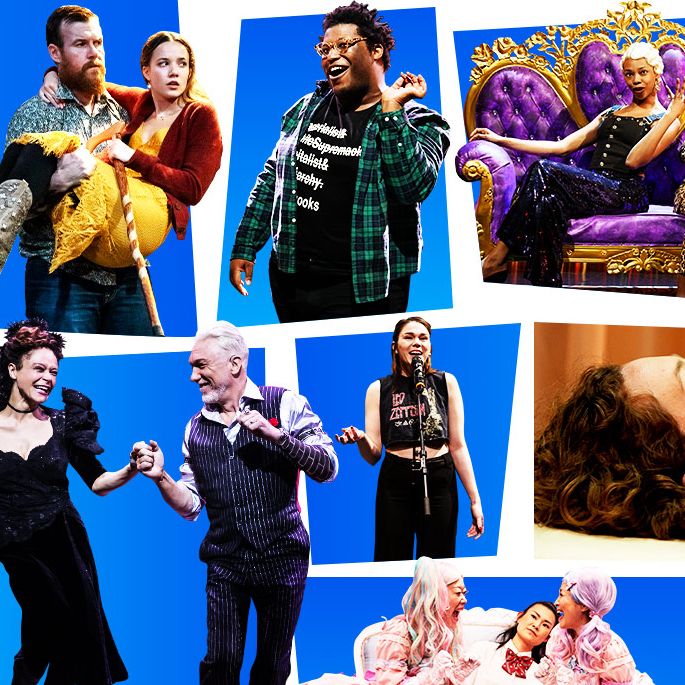
Many of the most influential and beautiful theater productions of this year were actually the best of previous years. What used to be an “out-of-town tryout” is now just something that happens 35 blocks south of 42nd Street. This sort of in-borough transfer happens all the time (Hamilton, The Band’s Visit, and for that matter A Chorus Line), but what was a trickle has become a flood, a flood that this year accounted for virtually all of the best shows uptown. Successes Off Broadway rode their buzz onto the Great White Way where they extravagantly flourished — bigger rooms and broader audiences embraced What the Constitution Means to Me, Slave Play, Rodgers and Hammerstein’s Oklahoma!, and Hadestown. Even David Byrne’s superb theatrical concert American Utopia looped through Brooklyn on tour before settling down more plushly at the Hudson Theatre. This is why a quite wonderful year on Broadway isn’t reflected in the list below. Uptown houses have five of the best shows on offer — they’re just the best of 2018, when they opened elsewhere, rather than 2019.
Off Broadway shouldn’t be thought of as just the R&D wing of Broadway, but this reinvigorated upstream current is a promising sign for our theatrical ecology. It means that producers trust audiences to understand weirder and riskier work, for one thing. None of the first four of the five pieces mentioned above were attached to marquee names; each took its place in the limelight without a television face or a movie star. It’s also exciting that all of them explicitly reconsider our suffrage-delaying, whiteness-coddling, wall-building country. Almost all of my top productions from this year, while wonderful entertainment, have that same seriousness of intent. If I won the lottery — or, thinking clearly about the numbers, ten lotteries — I’d put all of the following on Broadway next year. Let 2020 be the year of 2019.
10. Suicide Forest
The playwright/performer Kristine Haruna Lee’s wickedly comic nightmare — in which Japanese schoolgirls (including a character played by Lee) were hypersexualized while her actual mother crept like a ghost in the outer darkness — seemed like a portrait of a private hell. The pink walls oozed with spooky, blood-red, pendulous drops, but the characters themselves seemed robotic and lifeless, dead before their time. Then, out of nowhere, the production executed one of the year’s neatest heel-turns. Lee turned to the other Japanese American performers in the show (again, including her mother) and began asking them about identity. She took her existentially terrifying play into kindness, community, and shared burden, moving the piece out of the forest and into the light.
9. Ain’t No Mo’
Flight 1619 is now departing, America. If you’re black, the government is paying for your ride to, well, somewhere else, and the overworked airline attendant Peaches (the play’s author Jordan E. Cooper) needs you to grab your cultural freight and get onboard. In Cooper’s bitterly funny, loosely linked series of short scenes, we see frighteningly recognizable burlesques of a country that could generate such a fantasy: an abortion center where black women refuse to bring another child under the bootheel of racist supremacy; a reality show in which a white woman tries to “transition” into the black fabulousness she believes is her right; a loud Baptist burial service for the “right to complain” once Obama gets into the White House. Cooper’s writing is knifesharp, and Stevie Walker-Webb’s superb production at the Public Theater generated several of the season’s breakout performances, particularly Crystal Lucas-Perry, whose ability to be devastating and hilarious in the same moment encapsulated the whole furious project.
8. Little Shop of Horrors
Sometimes after a rough year, it’s nice to have a perfectly performed revival of a perfectly weird little musical about a perfectly evil little plant. That may be why Michael Mayer’s production of Alan Menken and Howard Ashman’s 1982 classic felt so much like water pouring into parched soil. Why? Is it so relatable that a fool at a flower shop starts a fad that turns into Vegetable Alien Apocalypse? Well, first, it has the most singable score in showbiz — your challenge is not to hum “Downtown” to yourself after reading this. And second, it exerts an almost hypnotic control over the bit of your brain that got excited about theater in the first place. Clearly the stars Jonathan Groff and Christian Borle were having the time of their lives, and something about seeing them revel in foolishness and mayhem felt positively contagious.
7. The Appointment
The Philadelphia-based physical-theater ensemble Lightning Rod Special returned to New York after their barnstorming show Underground Railroad Game with this tongue-in-uterus revue about abortion. The show starts with the company playing a bunch of fetuses — adults in draggly, somehow moist-looking unitards — spinning around on office chairs to imitate floating in a placenta and competing for the audience’s love. And, honey, that was the tasteful part. But in amongst Alex Bechtel’s songs about tearing one’s way into the world and various bananas bits of audience involvement, there were a few realistic scenes set in doctor’s offices. The fabric umbilical cords were tucked away, the actors sobered up, and the woman in a hospital gown was treated, well, as women are treated in such places. As wild as it was, I can’t remember ever so exactly recognizing the destabilizing way it feels to have a womb in America. Here’s the joke: Our bodies are the cabaret, old chum.
6. History of Violence
The German director Thomas Ostermeier makes shows of such casual virtuosity that it can feel easy to take them for granted — at least until you compare his use of multimedia, postmodern text, multiple viewpoints and deliberate mess to everybody else’s. In a year without a new Wooster Group production (they remounted their marvelous 2018 piece The B-Side: “Negro Folklore From Texas State Prisons”), History of Violence at St. Ann’s Warehouse was easily the best new game of this deconstructed nature in town. Adapting Édouard Louis’s autofiction about his own violent attack and rape, Ostermeier and his team layered storytelling techniques and framing devices on one another to first wrap the awful events in cotton wool, then to strip them bare. It takes a sophisticated approach to dive into the complexities of Louis’s real-world response to the assault — he refused to press charges because of his beliefs about French policing — and this elegant production made space for possibilities of nearly impossible forgiveness and understanding.
5. Heroes of the Fourth Turning
Will Arbery kicked the door down this year with two plays: the Off Broadway premiere of Plano, his witchy comedy about supernatural anxiety and sisterhood, and Heroes of the Fourth Turning, a heady brew of millennial terror and white Christian conservative dogma. A group of ex-classmates from a Catholic “Great Books” curriculum reunite in a back yard on the darkest night of the year to kvetch and bond and celebrate one of their old teachers. How should they deal with temptation in a godless America, they wonder, and just what does the new age require of them? Awful, unexplained noises belch out of the earth; the audience can’t stop thinking about the deer’s blood that has seeped under the patio. Plano might disturb and delight you but Heroes will change you, as it dares to open books never read aloud on New York stages.
4. Fefu and Her Friends
The Cuban-American experimental playwright María Irene Fornés is known mostly to academics and other playwrights, but her legendary 1977 production of Fefu and Her Friends is like that famous Sex Pistols show at the Free Trade Hall: Not a lot of people saw it, but everyone who did, started writing. Fornés, delighted by the limits of her original loft space, invented the boundary-breaking promenade structure, in which an audience is broken up to see different parts of the show in different sequences. Something about that radical deconstruction of the stage — even simply reading about it in a class — grabs people and makes them want to create their own plays. In Lileana Blain-Cruz’s beautifully realized production, Fefu still had such force and loveliness that you could hear it inspiring a new artist every minute. The great Fornés died last year, but her Fefu goes on making friends …
3. 50/50 old school animation
On the surface, it’s just a pair of monologues, nothing to be squeamish about. No blood, no creepy clowns, nobody popping out in a hockey mask. Yet this frightening little slice of horror (only about 50 minutes long) has been showing up regularly in my nightmares since the Public Theater’s festival of experimental theater Under the Radar. A bone-saw jolt from three avant-garde theatermakers — Julia Mounsey, Peter Mills Weiss and Mo Pasic — it taps into our actual deepest fear: betrayal. What if our friends are actually putting us in harm’s way? What if, just asking questions here, sociopathy is more common than we think? And what is it about a woman’s presence in the world that draws violence like a magnet? Honestly, I’m writing about this show a little bit like it’s the videotape in The Ring — now that I’ve talked to you about it, I desperately hope it will stop haunting me.
2. Is This a Room
The odd title comes from a line in the FBI interrogation transcript of Reality Winner, the NSA interpreter who leaked information about Russian hacking in the 2016 election. A bunch of FBI guys surround Winner at her home — the warrant is en route, you know — and sweetly, folksily, frighteningly bully her into full disclosure. Armed for war, the men crowd into her spare bedroom. Is this a room? Or is this our country? As political theater, the show was hugely effective. Considered as a piece of performance and production, Tina Satter/Half Straddle’s verbatim play — meaning the text comes exactly from the record rather than a playwright’s pen — was a triumph. It looked great (a slice of gray carpet in a hovering fog); it sounded gorgeous (Sanae Yamada’s eerie score made even the FBI redactions into pulsing tones). And Winner was clearly the role that Emily Davis has always been meant to play: pure, vibrating, vulnerable, and brim-full of the civic courage that only a handful of us ever show.
1. A Strange Loop
Michael R. Jackson had long been the insider’s pick for Man Most Likely to Write a Sondheimian Epic About Bottoming — he was the toast of grants and workshops and commissions and Joe’s Pub showcases for years. Finally, in 2019, the wider public got to see what he’d been working on, and we’re all still reeling from the impact. His ultrameta “Big Black and Queer-Ass American Broadway” musical about an usher named Usher who is writing a musical about his own life starred Larry Owens, a blazing celestial object in human form. Together, Jackson and Owens hit Playwrights Horizons like the comet that took out the dinosaurs — if by dinosaurs you mean commercialized blackness, timid descriptions of gay sex, white ladies at the intermission of The Lion King, Tyler Perry, homophobes who say they love you, racist Grindr hookups, and any tired old ideas of what a musical could actually be. I joke about the lottery, but I would absolutely donate Kickstarter cash toward putting this on Broadway. Let’s be heroes.
*This article appears in the December 23, 2019, issue of New York Magazine. Subscribe Now!


